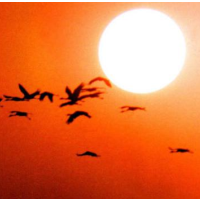Did Fried Birds Cook Proposed Desert Solar Project’s Goose?

State and federal agencies unveiled a broad, 25-year plan for development of renewable energy sources in California in September but the semi-approved giant solar power project near Joshua Tree National Forest won’t be one of them.
The consortium that was planning to build the Palen Solar Electric Generating System in the eastern Chuckwalla Valley, west of Blythe, formally withdrew the project shortly after a hailstorm of abuse over reports of birds being fried as they flew over Ivanpah Solar Electric Generating System, a similar facility in the Mojave Desert.
Palen was going to employ the same tower technology as Ivanpah, which uses hundreds of thousands of heliostat mirrors to focus the sun’s rays on 459-foot-high tanks of water, producing steam to run a conventional turbine that produces electricity. The Center for Biological Diversity estimates that 28,000 birds are cooked annually at Ivanpah; the owner, BrightSource Energy, puts the number at 1,000.
The birds are called “streamers” for the trail of smoke that follows behind them before they plunge to Earth.
Palen was said to be worse for avian traffic. The developers proposed building two 750-foot towers, but the California Energy Commission rejected that plan in December. Commission staffers said each of the towers would be more dangerous to birds than the three Ivanpah towers combined.
The Palen developers scaled back the solar plant’s footprint and agreed to just one tower, for now, and won approval from a commission committee last month. The commission was expected to approve the deal later this month.
A formal announcement of the withdrawal by BrightSource did not offer a reason and, while roasting feathered friends was an obvious factor, BrightSource Senior Vice President Joseph Desmond told the Desert Sun money was a big issue. The project would not qualify for a 30% investment tax credit if it weren’t completed by the end of 2016, he said. That wasn’t going to happen.
The 500-megawatt project was originally launched in 2009 by a different company using different technology. But Solar Millenium went bankrupt and the project was transferred to BrightSource, which then partnered with Spain’s Abengoa Solar using BrightSource’s tower technology.
Abengoa has built solar plants using solar parabolic trough technology, which Solar Millenium had planned to use. And Chris Clarke at KCET’s Rewire speculated that the project could be quickly revived and sped through the regulatory process by using technology already reviewed to some extent by the state.
California has established a goal of reducing energy emissions to 1990 levels by 2020 and set steeper reductions in ensuing years. The 25-year energy plan acknowledges that there will be an environmental price to pay for developing reusable sources and the proposal would “impose dramatic visual changes to high-value recreational areas.”
For now, that will not include a Joshua Tree landscape littered with cooked bird carcasses.
–Ken Broder
To Learn More:
California Solar Tower That Can Kill Birds Dropped (Associated Press)
Massive Solar Power Project for California Desert Scrapped (by Chris Clarke, KCET)
Plans for Palen Solar Farm Fizzle (by Janet Zimmerman, Riverside Press-Enterprise)
Will the BrightSource-Abengoa Tower Be the Last CSP Project in the US? (by Eric Wesoff, GreenTech Solar)
A Solar Bird Death Story Ignites Controversy (by Pete Danko, Breaking Energy)
Solar Farm in the Mojave Seen Igniting One Bird Every Two Minutes (by Ken Broder, AllGov California)
Massive 25-Year Desert Renewable Energy Plan Puts Environmentalists on Notice (by Ken Broder, AllGov California)
- Top Stories
- Controversies
- Where is the Money Going?
- California and the Nation
- Appointments and Resignations
- Unusual News
- Latest News
- California Forbids U.S. Immigration Agents from Pretending to be Police
- California Lawmakers Urged to Strip “Self-Dealing” Tax Board of Its Duties
- Big Oil’s Grip on California
- Santa Cruz Police See Homeland Security Betrayal in Use of Gang Roundup as Cover for Immigration Raid
- Oil Companies Face Deadline to Stop Polluting California Groundwater





